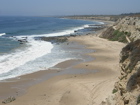
We parked at the north end of Reef Pt. parking lot and took the bluff trail to the north, here looking out at the beach and rocky reef where we went
| 
Same vantage point on bluff but looking out slightly to the south at Reef Pt. (site of previous visit)
| 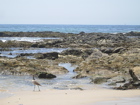
Marbled godwit and reef - we also saw long-billed curlews, willets, turnstones, various peeps, and an interesting oystercatcher
(see below)
|
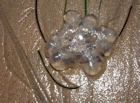
Unidentif. part of scyphozoan
| 
Image Caption
| 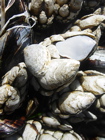
Lottia austrodigitalis on
Pollicipes polymerus
|
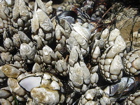
Lottia austrodigitalis on
Pollicipes polymerus
| 
Abundant clonal anemones
(Anthopleura elegantissima)
| 
Clonal anemones possibly outcompeting mussels for primary attachment space
|
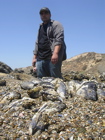
Image Caption
| 
Image Caption
| 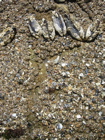
A "no-man's land" between anemone clones, perhaps expanded by chiton and limpet grazers
|
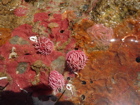
Hopkinsia rosacea with egg mass
| 
Hopkinsia rosacea with egg mass
| 
Scaleworm on bryozoan and compound tunicate
|
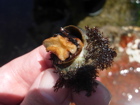
Image Caption
| 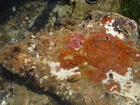
Image Caption
| 
Lottia gigantea on its farmed territory
|

California mussels, clonal anemones, and ochre seastar
| 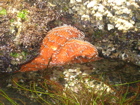
Pisaster ochraceus
(ochre seastar)
| 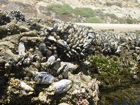
Hummocks of mussels
and gooseneck barnacles
|
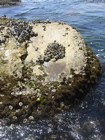
Lottia gigantea (owl limpet) territories
| 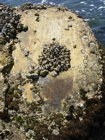
Lottia gigantea (owl limpet) territories
| 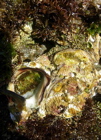
Nuttallina fluxa (southern spiny chiton) in empty Pseudochama exogyra (reversed chama) shell
|
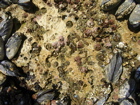
Nuttallina fluxa home depressions
| 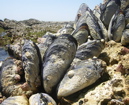
Extreme large (and probably old) California mussels (Mytilus californianus)
| 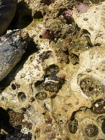
Nuttallina fluxa in home scars
|
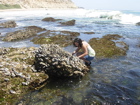
Image Caption
| 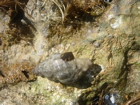
cf. Ceratostoma nuttalli with unidentified limpet on its back
| 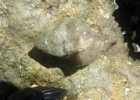
cf. Ceratostoma nuttalli (but this snail had a well-developed tooth as in Acanthina)
|

Image Caption
| 
Sponge (unidentified)
| 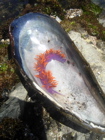
Spanish shawl nudibranch
(Flabellina iodinea)
|
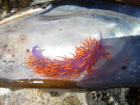
Flabellina iodinea
| 
Flabellina iodinea
| 
Flabellina iodinea
|

Flabellina iodinea
| 
Under ledge habitat (viewed with mirror): Tetraclita rubescens and Lottia spp., especially L. conus
| 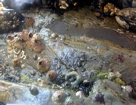
Under ledge habitat
|
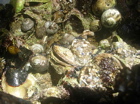
Pseudochama exogyra
(reversed chama)
| 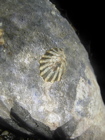
Lottia conus
| 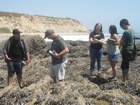
Image Caption
|

Trimusculus reticulatus (suspension feeding pulmonate limpet) under a ledge as viewed with a mirror
| 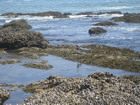
This oystercatcher has a white underside, like the American oystercatcher (Haematopus palliatus), which is only rarely found north of Baja California. More normally the black oystercatcher (H. bachmani) is seen in California. According to Dr. Weintraub, it could be a hybrid. See American vs. black: 1 - 2 - 3 and key to identifying a hybrid here. I think its singing was more like a black oystercatcher (compare 1 vs. 2)
| 
Image Caption
|
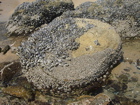
Image Caption
| 
Image Caption
| 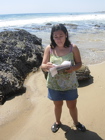
Report on decapod crabs
|

Image Caption
| 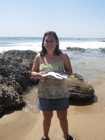
Image Caption
| 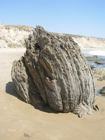
Image Caption
|
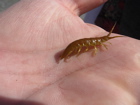
Idotea sp. found on drift Egregia
| 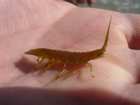
Idotea sp.
| 
Elk kelp (Pelagophycus porra)
|

Elk kelp (Pelagophycus porra)
| 
Unidentified shorebirds
| 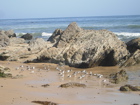
Unidentified shorebirds
|
 Under Construction!
Under Construction! Under Construction!
Under Construction!